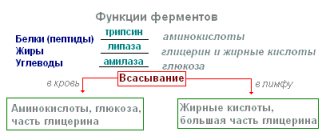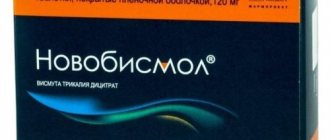Types of enzymes
- Pepsin. An enzyme is a substance that is produced in the stomach. It acts on protein molecules in food, breaking them down into their elementary components - amino acids.
- Trypsin and chymotrypsin. These substances are part of the group of pancreatic enzymes, which are produced by the pancreas and delivered to the duodenum. Here they also affect protein molecules.
- Amylase. An enzyme is a substance that breaks down sugars (carbohydrates). Amylase is produced in the mouth and small intestine. It decomposes one of the main polysaccharides - starch. The result is a small carbohydrate - maltose.
- Maltase. The enzyme also affects carbohydrates. Its specific substrate is maltose. It breaks down into 2 glucose molecules, which are absorbed by the intestinal wall.
- Saharaza. Protein acts on another common disaccharide, sucrose, which is found in any high-carbohydrate food. Carbohydrates break down into fructose and glucose, which are easily absorbed by the body.
- Lactase. A specific enzyme that acts on the carbohydrate from milk - lactose. When it decomposes, other products are obtained - glucose and galactose.
- Nucleases. Enzymes from this group act on nucleic acids - DNA and RNA, which are contained in food. After exposure, substances break down into individual components - nucleotides.
- Nucleotidase. The second group of enzymes that acts on nucleic acids is called nucleotidases. They decompose nucleotides to produce smaller components - nucleosides.
- Carboxypeptidase. The enzyme acts on small protein molecules - peptides. As a result of this process, individual amino acids are obtained.
- Lipase. The substance decomposes fats and lipids entering the digestive system. In this case, their components are formed - alcohol, glycerin and fatty acids.
Read on the topic: How long does it take for food to be digested in the human stomach?
Some enzymes that break down proteins
But what can be done to ensure that the level of proteins in the body does not exceed the required limits? Enzymes that break down this component play an important role. The main enzymes responsible for this “mission” include sucrose, lactose and amylase. The share of amylase is the largest part, about 90% of the total content of organic substances. This is an enzyme that breaks down proteins, which does an excellent job with proteins that have complex carbohydrates in their chemical composition.
Excess digestive enzymes
Excess digestive enzymes are most often observed with a disease such as pancreatitis. The condition is associated with the overproduction of these substances by pancreatic cells and a violation of their excretion into the intestines. In this regard, active inflammation develops in the organ tissue, caused by the action of enzymes.
Signs of pancreatitis may include:
- severe pain in the abdominal area;
- nausea;
- bloating;
- violation of stool character.
A general deterioration in the patient's condition often develops. General weakness, irritability appear, body weight decreases, and normal sleep is disturbed.
What enzymes does the pancreas produce and why?
The pancreas secretes enzymes: lipase to digest fats, protease to digest proteins, amylase to digest carbohydrates. This is one of the main functions of the organ. The second, no less significant, is the production of the hormones insulin and glucagon, which regulate blood sugar levels. The development of diabetes mellitus is directly related to the condition of the pancreas. But that’s not about that now.
The gland secretes about 1-2 liters of enzymes per day. Quite a decent volume, don’t you agree? The pancreas produces them in large reserves: about 10 times more than needed. Therefore, in order for a person to feel a lack of his own digestive enzymes, their production must drop by 80-90%.
The key enzyme is lipase, which digests fats. She stands out the most. Lipase does not work without bile, so the pancreas acts “in conjunction” with the gallbladder. It is not surprising that these two organs often affect each other’s condition: pancreatitis (inflammation of the pancreas) can provoke cholelithiasis, and vice versa, gallstone problems can quickly become pancreatic problems.
To digest plant foods - vegetables, fruits, herbs and other things - digestive enzymes are not needed. This function is performed by bacteria living in the intestines.
What do elevated liver enzymes ALT and AST indicate? Transaminitis or hypertransaminasemia is a condition that is associated with increased levels of transaminases - the liver enzymes ALT and AST. Transaminitis is not a disease, but it may indicate a health problem that requires treatment.
How to identify disturbances in the synthesis of digestive enzymes?
- Stool examination. The detection of undigested food residues in the stool indicates a disruption in the activity of the intestinal enzymatic system. Depending on the nature of the changes, it can be assumed which enzyme is deficient.
- Blood chemistry. The study allows you to assess the patient’s metabolic state, which directly depends on the activity of digestion.
- Study of gastric juice. The technique allows you to evaluate the content of enzymes in the stomach cavity, which indicates the activity of digestion.
- Study of pancreatic enzymes. The analysis makes it possible to study in detail the amount of organ secretion, thanks to which the cause of the violations can be established.
- Genetic research. Some enzymopathies may be hereditary. They are diagnosed by analyzing human DNA, in which genes corresponding to a particular disease are found.
Do you need additional enzymes?[edit | edit code]
If you are adequately training and recovering, but there is no progress, then, obviously, the problem lies in insufficient calorie intake. It is necessary to gradually increase the calorie content of the diet. But only through quality products, following nutritional rules. Continue to increase your caloric intake for at least 2 weeks and then start drawing conclusions. If you are still not gaining strength and mass, check to see if you have any symptoms of stomach digestive enzyme deficiency:
- Unpleasant sensations in the stomach immediately after eating.
- Violent belching after eating.
- A feeling of “fullness” in the stomach that lasts for quite a long time.
- Upset stomach after eating a large meal.
- Upset stomach after several small meals.
Another common type of digestive disorder is a lack of enzymes in the small intestine. It is characterized by other symptoms:
- "Burning" and bloating.
- Feeling of discomfort in the abdominal cavity.
- Flatulence
- Frequent diarrhea.
- Brightly colored, loose or strong-smelling stool.
- Mucus in the stool.
If you notice any of these symptoms appearing when switching to a high-calorie diet, it is likely that you need to take digestive enzymes. To find out for sure, reduce your calories to normal levels and monitor what happens to your symptoms. If they disappear, it means you really need enzymes.
Please note that some of the listed symptoms can be caused not only by a lack of enzymes, but also by certain diseases, food allergies, neuroses and hypersensitivity. If you are not sure of the reason, consult your doctor.
Basic principles of therapy for enzyme disorders
A change in the production of digestive enzymes is a reason to consult a doctor. After a comprehensive examination, the doctor will determine the cause of the disorders and prescribe appropriate treatment. It is not recommended to deal with pathology on your own.
An important component of treatment is proper nutrition. The patient is prescribed an appropriate diet, which is aimed at facilitating the digestion of food. It is necessary to avoid overeating, as this provokes intestinal disorders. Patients are prescribed drug therapy, including replacement treatment with enzyme preparations.
Specific medications and their dosages are selected by the doctor.
Penzital is recognized as one of the most effective drugs in enzyme therapy. Penzital is a pancreatin-based drug that improves the condition of the gastrointestinal tract and normalizes human digestive processes.
Penzital regulates the secretion of the pancreas; the enzymes included in pancreatin promote the breakdown of proteins, fats and carbohydrates into simpler components, which allows them to be absorbed more easily. Also, Penzital does not contain bile components, so it does not increase pancreatic secretion and can be used for diseases of the liver and gall bladder. Penzital is suitable for people with chronic pancreatitis, pancreatectomy, dyspepsia, gastrocardial syndrome and cystic fibrosis; people who have undergone irradiation; people with frequent attacks of flatulence and non-infectious diarrhea. It can be used after resection of the stomach and small intestine; with chewing function disorders in old age, sedentary lifestyle, prolonged immobilization; in preparation for x-rays. examination and ultrasound of the abdominal organs.
In continuation of the topic, be sure to read:
- Details about the coprogram: preparation, conduct and interpretation of the analysis
- List of enzymes to improve digestion and their intake
- Undigested starch in the stool of an adult: causes and principles of treatment
- Causes of bloating and increased gas formation, treatment methods
- Steatorrhea: types, causes, symptoms and treatment
- Putrefactive dyspepsia: how does it manifest itself and what does the symptom complex mean?
- Function of absorption of substances in the intestines
- What medications should I use for increased gas formation?
- Undigested food in a child’s stool: why does it appear and what does it mean?
- What is included in human saliva and what are its functions?
Breakdown of proteins in the stomach
The breakdown of protein in the stomach is a multi-stage process. About 97% of proteins that have undergone breakdown are absorbed in the form of free amino acids directly into the human blood.
The gastrointestinal tract, thanks to its enzyme apparatus, easily breaks down proteins into so-called peptide bonds of molecules. All this happens in stages, and also exclusively on a selective basis. When one amino acid is detached from a protein molecule, a peptide and an amino acid are formed. After this, after a certain time, another amino acid is cleaved off from the peptide, then the next one. A similar action occurs until the molecule is completely, without a residue, broken down into an amino acid.
What acid is included in gastric juice?
Hydrochloric acid is part of gastric juice. It is formed by the parietal cells of the organ.
According to anatomy, the gastric mucosa is divided into two areas. One is responsible for the production of HCl, the other for the synthesis of bicarbonates. The latter are necessary to neutralize hydrochloric acid. They prevent its negative impact on the sensitive gastric mucosa.
Interesting to know! Males have a higher percentage of parietal cells than females. And the production of hydrochloric acid is higher.
In percentage terms, HCl prevails over other acids several times. A high level of lactic acid may indicate insufficient formation of hydrochloric acid.
The concentration of HCl contained in gastric juice is 160 mmol/l. A highly concentrated solution could completely burn out the organ mucosa. Protective substances prevent an irreversible situation from occurring.
HCl is produced in three stages:
- The smell and taste of food causes the transmission of a nerve impulse to the cells of the stomach.
- When food stretches the walls of the stomach, the hormone gastrin is released. Under its influence, HCl is released by parietal cells.
- When digested food enters the duodenum, the hormone somatostatin is produced. It blocks the release of hydrochloric acid from cells.
What is the role of hydrochloric acid in gastric juice
The acid that is part of the gastric juice has the following functions:
- It promotes the breakdown of protein molecules and swelling.
- The acid activates pepsinogen, turning it into pepsin.
- The created acidic environment promotes the destruction of pathogenic microorganisms and better breakdown of proteins.
- Under the influence of HCl, the activity of the gastrointestinal tract is regulated. The enhancement or inhibition of nervous and humoral influences on the functioning of the gastrointestinal tract depends on the pH level.
Normal levels of the main component of gastric juice ensure the proper functioning of the digestive system.
Chemical composition of gastric juice
An inquisitive patient or 8th grade student is interested in knowing what chemicals are part of gastric juice. After all, they trigger the basic mechanisms of digestion.
The liquid consists of two main components: water and dry. The dry residue is represented by organic and inorganic compounds.
Inorganic components include:
- water;
- chlorides;
- sulfates;
- phosphates;
- hydrocarbonates;
- ammonia.
Without the listed components of gastric juice, digestion is impossible.
Table 1. Inorganic composition of gastric juice and the role of components in the digestion process
| Substance | Concentration | Its function |
| HCl | Its concentration is 160 mmol/l | The chemical destroys pathogenic microorganisms. HCl creates acidic conditions necessary for enzymes to function |
| Phosphates | 10—60 mg/l | Participate in chemical processing of food |
| Sulfates | 10 mg/l | Have a similar effect |
| Chlorides | 5–6 g/l | pH regulation |
| Hydrocarbonates | 0—1.2 g/l | Takes part in chemical reactions to digest food and protect mucous membranes |
| Ammonia | 10 mg/l | Product of biochemical processes of stomach cells |
Honey
Honey is rich in many beneficial substances, including digestive enzymes (up to 10%).
The main biologically active substances, according to scientists, are: diastases, amylases, proteases and invertases (they break down sucrose into glucose and fructose).
Honey improves the breakdown and subsequent absorption of almost all basic substances supplied with food (starch, sucrose, proteins), with the exception of fats.
Also, according to Italian cosmetologists, the high content of digestive enzymes has a beneficial effect on the skin (especially when applied topically). There is a softening and moisturizing of the skin, a slowdown in the formation of wrinkles, and a reduced risk of developing infectious and inflammatory diseases.
It is important to note that only natural honey that has not been subjected to heat treatment has beneficial properties (temperatures over 60 degrees contribute to the destruction of enzymatic components).
Honey contains a large number of digestive enzymes, which have a positive effect not only on the digestive system, but also on the skin.











